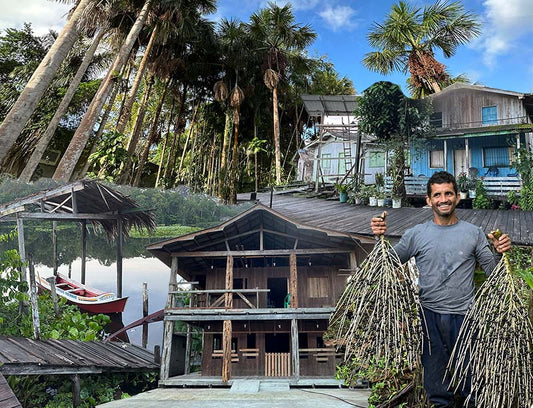The Amazon rainforest, often referred to as the "lungs of the Earth," is a treasure trove of biodiversity and natural resources. Among its many gifts, the Açaí tree stands out as a keystone species for the communities that call the Amazon Rainforest their home.
In this blog, we will explore the multiple uses of the Açaí tree by the people of the Amazon and how SAMBAZON, a brand committed to the biodiversity of the Amazon Rainforest, transforms this remarkable fruit into delicious products.
Açaí Tree: The Amazon's Versatile Keystone Species

-
Nutrient-Rich Açaí Berries
At the heart of the Açaí tree's significance lies its fruit – the Açaí berry. These small, dark purple berries contain essential nutrients such as antioxidants, healthy fats, fiber, and amino acids. For centuries, Amazonian communities have relied on Açaí as a staple food source, using it to create a nutritious and delicious pulp.
As summarized in The Amazonian Caboclo and the Açaí Palm: Forest Farmers in the Global Market, Eduardo S. Bondízio explains: “Along with manioc flour, açaí fruit has provided a continuous caloric base for the rural diet during different historical periods of the region, from floodplain chiefdoms to missionary occupation, and through the period of social transformation marked by directorate policies and the boom and bust of the rubber economy.”
-
Traditional Amazonian Cuisine
The Açaí berry is a fundamental ingredient in Amazonian cuisine. Local communities use it to prepare a variety of dishes, such as "Açaí bowls" and "Açaí tapioca." These dishes are not only delicious but also provide sustenance for the challenging tasks of daily life in the Amazon. Bondízio states, "During the main production season, açaí fruit represents from 15% to 30% of rural households’ caloric intake.”
Curious what other ways Brazilians eat Açaí? “It is usually consumed at meals with manioc flour, fish, beef, game, shrimp, or occasionally with sugar and ice (when available),” says Bondízio. That is very different from the frozen Açaí Bowls that most of the world knows! One local saying included in Bondízio’s book is “sem açaí continuo com fome (without açaí I’m still hungry).”
-
Medicinal Uses of Açaí
Açaí is not just a food to those in the Amazon; many consider it to also be a medicine. Amazonian healers have long recognized the berry's potential in treating various ailments. It's believed to have anti-inflammatory properties, locally it is used in alleviating joint pain and other symptoms. The acai root may have medicinal uses too. Research into the many uses of Açaí is a growing area of medical research.
-
Açaí Used as Raw Material
Açaí is used as a raw material in buildings and household utensils. Bondízio explains that “while some materials are substituted when alternatives are available, palms are always appreciated for their durability, esthetics, and cost.” He goes on to explain that palms are used in building fishing gear, and sometimes as roofing as “houses built with plant parts maintain a comfortable temperature inside.” It also has other potential industrial uses; Bondízio explains that it could be made into “paper pulp (trunk), oil (fruit/pulp), animal fodder (fruit/seed), organic soil (seeds), and ink (fruit/pulp).”
-
Heart of Palm
The Açaí tree can be harvested for their hearts, unfortunately this does kill the tree. Luckily, now that the berry is so popular it is less likely that an Açaí tree will be collected for this purpose.

-
Sustainable Management
Açaí trees are maintained by local and indigenous people, contributing to the preservation of the Amazon rainforest. By cultivating Açaí, local communities are incentivized to protect their land from deforestation and maintain the delicate balance of the ecosystem. As Bondízio explains, “during the last two decades, açaí fruit has become the most important income source for a vast majority of riverine households, as well as in many rural areas and indigenous reserves around the region.”
Led by Dr. Gabriel Damasco, an independent Biodiversity study, was reported on in the article “Certification of Açaí agroforestry increases the conservation potential of the Amazonian tree flora,” published in January 2022, focusing on Amazon Rainforest tree species. The study revealed the significance of certified sustainable agroforestry in mitigating the negative environmental effects of unregulated extraction.
Certified managed forests were found to host over 50% more tree species, offering enhanced protection and habitat for plants and animals. Açaí palms acted as pioneer species, aiding the growth of old-growth trees that are crucial for habitat preservation and carbon storage. Furthermore, certified harvesting sites exhibited dense populations of threatened species, highlighting the value of sustainable practices in safeguarding Amazon Rainforest biodiversity. The study also indicated that moderately managed Açaí areas with fewer tree cuts displayed higher species richness, suggesting the efficiency of Fair Trade certified Açaí management in conserving native trees.
SAMBAZON: A Commitment to the Sustainable Management of the Brazilian Amazon
Ethical Sourcing
SAMBAZON takes pride in sourcing Açaí berries directly from the Amazonian communities that have preserved and nurtured these trees for generations. By working with local harvesters, SAMBAZON supports sustainable practices and maintains fair compensation for their efforts.

Certified Organic and Fair-Trade Practices
SAMBAZON places a strong emphasis on maintaining Certified Organic and Fair-Trade harvesting methods. SAMBAZON's commitment to protecting the health of the Amazon rainforest aligns with the values of those who live and work in this region. Bondízio explains, “Through Açaí, the consumer is put in direct touch with the symbolic power of Amazonian nature, Indigenous wisdom, and a socioenvironmental cause.”
SAMBAZON's Nourishing Products
SAMBAZON's product line displays the incredible versatility of Açaí berries. From Açaí bowls to juices and smoothie packs, we offer delicious, convenient ways for people around the world to enjoy the delicious powers of this Amazonian fruit.
Preserving The Açaí Tree
The Açaí tree serves as a powerful symbol of the Amazon Rainforest. By supporting local communities and helping to maintain the Amazon rainforest, SAMBAZON ensures that the Açaí tree and its many gifts continue to flourish for generations to come.
As you savor a SAMBAZON Açaí product, remember the connection between your meal and the vibrant culture and ecology of the Amazon rainforest. Your choice to enjoy SAMBAZON contributes to the preservation of a living, breathing ecosystem and the livelihoods of the people who call it home.
Source
Brondízio, Eduardo S. (2008). The Amazonian Caboclo and the Açaí Palm: Forest Farmers in the Global Market. The New York Botanical Garden Press.








Comments
(0 Comments)Please note, comments need to be approved before they are published.